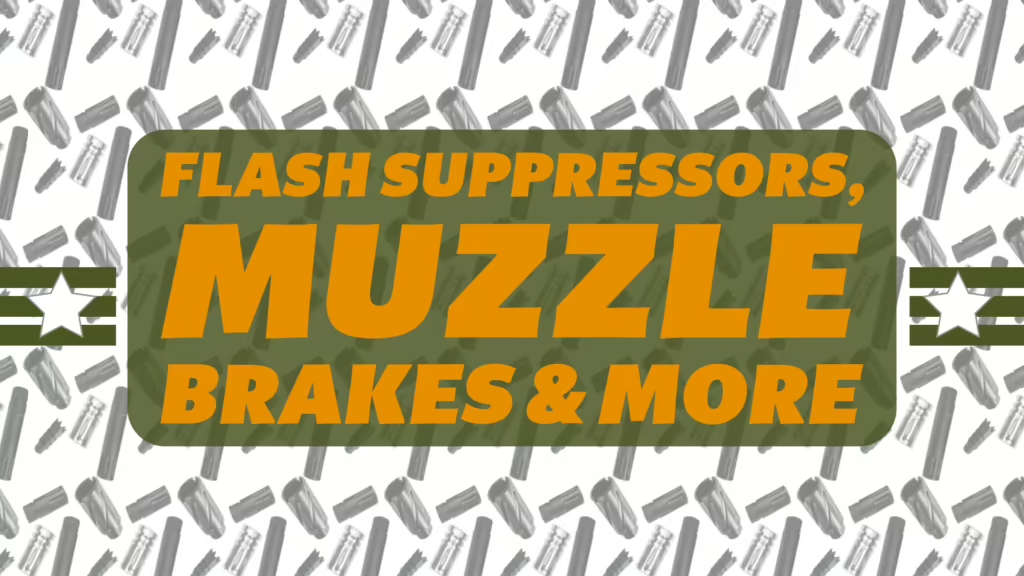
This week’s post is on muzzle devices, the different types, their intended purposes, and even
some suggestions this time. Choosing the right muzzle device for your rifle can be a headache, but we got you covered!

Muzzle devices are the objects we thread onto the end of a barrel to modify something about
the weapons’ performance. There are many to choose from these days, including some odd
amalgamations from companies reinventing the wheel, but there is also some really helpful
technology. The most common types, generally speaking, are flash suppressors, muzzle breaks,
and compensators, and we’ll also discuss silencers and blast diverters. And yes, they are called
silencers.
Choosing the right muzzle device for your rifle Part 1
First, we’ll cover flash suppressors. They do exactly what it sounds like, just not entirely. I
suppose I should first explain why the flash happens a weapon is fired. It’s pretty simple: once
you fire a round, the powder ignites and turns to very hot gas. That gas travels down the barrel
and out the muzzle, where it is introduced to much cooler oxygen. As soon as it meets the
oxygen, it ignites, causing a flash. A flash suppressor usually has at least one of two things:
sharp cuts into the bore of the device, or tines (also called prongs) that are cut angularly. Either
of these features help to reduce flash by allowing quick redirection and dispersion of hot gas
from the muzzle. The reason flash suppressors won’t entirely eliminate flash is because the gas
is still just as hot, and there’s just as much of it so it does still ignite, it’s just spread out instead
of in a nice tight ball. For a combat rifle or fighting rifle, I would suggest using a flash
suppressor, or flash suppressor/compensator hybrid. The pictured rifle has a pinned/welded
SOLGW Nox device that is a flash suppressor/compensator hybrid, with a suppressor QD
lockup (Dead Air KeyMount system).

Linear compensators are focused on recoil. Compensators have ports cut into the bore in
specific locations so that gas will escape in one general direction, pushing the muzzle in the
opposite direction. Compensators are generally better for more snappy guns. A lot of people
have compensators on their pistols, such as myself, and you’ll also occasionally see them on
faster-firing guns, but in my experience even this is rare. Other than recoil correction, they don’t
serve another purpose.
Muzzle breaks are a popular one. Very similar to linear compensators, they have holes cut,
usually creating an acute angle to the barrel, to redirect gas. The main difference is that muzzle
breaks don’t aim to push gas in a certain direction other than relatively rearward, pushing the
rifle slightly forward, reducing overall felt recoil. A lot of people mistake the job of a break for the
job of a compensator. Compensators won’t alleviate as much overall recoil, but they can correct
the recoil direction greatly, if timed properly.

I’ll take a moment here just to mention that any of the muzzle devices we just talked about can
also come in the form of a silencer host. Meaning, the muzzle device also has the male Quick
Detach (QD) lockup to mount a silencer, the silencer itself having the female portion. I would
recommend that if you’re in the market for a muzzle device, especially if you’re going to pin and
weld it, also do some research on suppressors. Dream a little, and find the suppressor that, if
any, you could possibly want to get someday for this rifle. Then, get whatever muzzle device you
were going to get, but with the QD option for that silencer. That way, especially if you pin and
welded the device on, you wouldn’t have to swap parts (potentially a couple expensive parts) if
you ever did end up with the silencer just to attach it to your rifle.
Choosing the right Suppressor Part 2
Now we can dive into silencers. First off, I have to say it, they don’t make your rifle silent. In fact,
if you choose 5.56 as your caliber for the fighting rifle, there isn’t a silencer on the market as of
this post that makes your rifle even just hearing-safe. This is where the term suppressor comes
from, as it doesn’t silence anything. It suppresses sound but more importantly, in some cases it
can completely eliminate flash. This is why I would recommend that any fighting rifle be
suppressed. More important than the drop in decibel value, the silencer changes the pitch and
tone of the gunshot. This makes it much more difficult to pinpoint where the sound is coming
from. Combine that with the near or complete elimination of flash, and the total signature of the
shot is greatly reduced, enough to change the risk assessment (we’ll get into risk assessment in
a “Boring Stuff” series down the road).

As far as silencer technology, there hasn’t been a whole lot that’s changed since their invention.
As far as mounting options, you have two choices: direct thread, which just threads onto the
barrel where a muzzle device would go, or QD, which we talked about earlier. There are many
different QD systems on the market currently, so do your research and find one you like. For the
inner workings, there are a couple of variations of the same general technology. Inside the
silencer, you have a series of baffles that trap gas in series down the tube. Trapping the gas as
it exits the barrel does a couple of things: first, it slows the whole escape process down,
allowing the gas to cool before meeting oxygen, reducing flash and some noise (the noise of the
gas igniting to be exact). It also acts as a muffler for the sound, by simply creating a controlled
release of gas into the air. Flow-through silencers are fairly new and provide some new
pros/cons. First of all, a flow-through silencer doesn’t have a traditional baffle stack on the
inside. They have channels that catch the gas as it exits the barrel, and then those channels
travel in a helical pattern along the silencer and then exit through the front. I consider this sort of
an almost-silencer. What I mean by that is that all of the jobs of a silencer are done slightly
worse, but there’s a trade-off and that trade-off is in parts wear and shooter comfort. When you
shoot suppressed, you’ll see what I mean. Silencers trap gas that would’ve otherwise
immediately vented. That gas creates back pressure, as well as a higher volume of gas overall
traveling rearward in the receiver. This extra gas will wear out parts faster (barrel, gas system,
bolt carrier group), and will also escape through the rear of the receiver. There are parts to
mitigate this, which I’ll address as we get to them, but it’s something to be aware of. The
pictured silencer is a Dead Air Sandman-L.
Lastly, blast cans, blast diverters, blast shields, whatever you want to call them, they’re the
things that look like little stubby silencers, except that they don’t have baffles or sometimes even
an end cap. These use the same QD lockups as silencers, but their only job is to reduce
concussion by directing all gas and sound forward. It’s pretty simple, it’s basically just a hollow
can that blocks all the ports on your muzzle device. It’s hard for me to justify these, I’d always
advise someone to just get a silencer instead, but if you’re really looking for a reason, they are
good on the range for not disrupting shooters around you, if you don’t have a silencer yet.
That’s all I have this week, hope that points you in a good direction for your build, or if you’re just
here for the info, I hope I covered it in a way that makes sense! Next week we’ll have two posts
because the gas system is a pretty short one to cover, so I’m also going to make a post for
rails/hand-guards.












